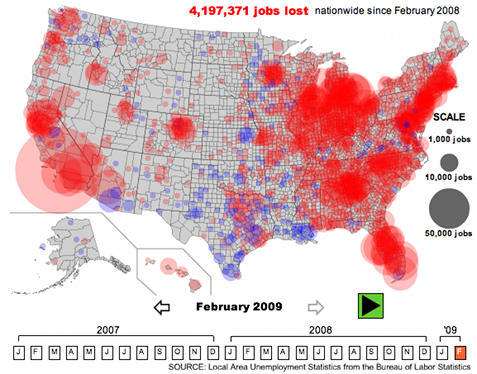Archive for January, 2011
Too afraid to make money and create jobs.
 What if you could double your factory throughput without adding people?
What if you could double your factory throughput without adding people?
What if you could reduce your product costs by 50%?
How much money would you make?
How many jobs would you create?
Why aren’t you doing it?
What are you afraid of?
The Job Loss Implosion
If you do one thing, click this link. (Or the graphic itself.) Please. You’ll be sent to a page where you can watch an animation of US job losses. I was debilitated after watching the implosion.
Here’s how I reacted to the animation:
Disbelief. No way. Not real. I checked the data. It’s real.
Fear. Look what happened to my country!
Anger. Why isn’t everyone talking about this? Why aren’t we doing something about this? Why are we saying the economy is on the mend? That’s crap, I-want-to-get-reelected type crap. (To be clear, I think great progress has been made.) Truth is it cannot be mended with the current approach. It cannot. If possible at all, it will take a borderline-Draconian approach, where cuts are made and taxes are raised to radically fund innovation, technology, and manufacturing. (Think energy, energy, energy.) Reinvestment in ourselves.
Sadness. Our lifestyle, as we know it, is over. The American Way has imploded; we just don’t have the courage to face it yet.
Sadness. This is not good for my kids. (And that’s when I changed my thinking.)
Hope. We can do something about this. It will be exceedingly difficult, but we can do it. We’re smart enough. We’ll have to make hard choices, choices where we get less and pay more – a net reduction in our standard of living. It will take sacrifice, real sacrifice. Sacrifice at the standard of living level, sacrifice inline with WWII-caliber, go-without sacrifice. Sacrifice to free up radical amounts of money to invest in our country, in our innovation, in our technology, and in ourselves. I’m talking about self-investment at levels that make the Apollo Program look like chump change, self-investment that makes the war look like a bargain. The toughest part, however, is how to elect politicians on a platform of get less and pay more, a platform of sacrifice, of tough choices. I’m not talking about talking about tough choices, but actually making tough choices, choices for the common good. I’m talking about a platform that demands true, unselfish behavior by all.
Action. I will write to raise awareness. I will post to raise awareness. I will tweet to raise awareness. I will speak (if not yell) to raise awareness. I will continue to educate on how to fix it. I will reach out to people who can make a difference. I will pester them. I will pester them again. For my kids and yours, I will not give up.
What will you do?
Daily tweets will start today.
 Starting today I will be sending out a daily tweet (five per week.) I’ll comment on interesting web content or send a short thought. The content will be in line with my blog posts — innovation, product development, the economy, people, and teams.
Starting today I will be sending out a daily tweet (five per week.) I’ll comment on interesting web content or send a short thought. The content will be in line with my blog posts — innovation, product development, the economy, people, and teams.
To follow me on Twitter and receive my daily tweets, click this link — @MikeShipulski. Or, click on the small Twitter icon just above my head.
Please forward this note to those that may want to get my tweets.
Mike
Your product costs are twice what they should be.
 Your product costs are twice what they should be. That’s right. Twice.
Your product costs are twice what they should be. That’s right. Twice.
You don’t believe me. But why? Here’s why:
If 50% cost reduction is possible, that would mean you’ve left a whole shitpot of money on the table year-on-year and that would be embarrassing. But for that kind of money don’t you think you could work through it?
If 50% cost reduction is possible, a successful company like yours would have already done it. No. In fact, it’s your success that’s in the way. It’s your success that’s kept you from looking critically at your product costs. It’s your success that’s allowed you to avoid the hard work of helping the design engineering community change its thinking. But for that kind of money don’t you think you could work through it?
Even if you don’t believe 50% cost reduction is possible, for that kind of money don’t you think it’s worth a try?
A Unifying Theory for Manufacturing?
 The notion of a unifying theory is tantalizing – one idea that cuts across everything. Though there isn’t one in manufacturing, I think there’s something close: Design simplification through part count reduction. It cuts across everything – across-the-board simplification. It makes everything better. Take a look how even HR is simplified.
The notion of a unifying theory is tantalizing – one idea that cuts across everything. Though there isn’t one in manufacturing, I think there’s something close: Design simplification through part count reduction. It cuts across everything – across-the-board simplification. It makes everything better. Take a look how even HR is simplified.
HR takes care of the people side of the business and fewer parts means fewer people – fewer manufacturing people to make the product, fewer people to maintain smaller factories, fewer people to maintain fewer machine tools, fewer resources to move fewer parts, fewer folks to develop and manage fewer suppliers, fewer quality professionals to check the fewer parts and create fewer quality plans, fewer people to create manufacturing documentation, fewer coordinators to process fewer engineering changes, fewer RMA technicians to handle fewer returned parts, fewer field service technicians to service more reliable products, fewer design engineers to design fewer parts, few reliability engineers to test fewer parts, fewer accountants to account for fewer line items, fewer managers to manage fewer people.
Before I catch hell for the fewer-people-across-the-board language, product simplification is not about reducing people. (Fewer, fewer, fewer was just a good way to make a point.) In fact, design simplification is a growth strategy – more output with the people you have, which creates a lower cost structure, more profits, and new hires.
A unifying theory? Really? Product simplification?
Your products fundamentally shape your organization. Don’t believe me? Take a look at your businesses – you’ll see your product families in your org structure. Take look at your teams – you’ll see your BOM structure in your org structure. Simplify your product to simplify your company across-the-board. Strange, but true. Give it a try. I dare you.
2010 – Mike’s year in review
 I looked back at 2010 and put together the list of things I shipped. (I got the idea from Seth Godin.) I made the list for me, to make sure I took some time to feel good about me and my work. I do.
I looked back at 2010 and put together the list of things I shipped. (I got the idea from Seth Godin.) I made the list for me, to make sure I took some time to feel good about me and my work. I do.
I want to share the list with you (because I’m proud of it). So here it is:
65 posts (goal was 52)
4 articles –
- Cured Offshoring (Machine Design)
- Did Modular Design (Mechanical Engineering Magazine)
- Controlled Controller Design (Design2Part)
- Went Back to Basics with DFMA (Knovel)
Workshop on DFMA Deployment
Keynote presentation DFMA Forum
Started a LinkedIn working group on Systematic DFMA Deployment
Pretended to be a country
Wrote an obituary for Imagination
Sought out Vacation’s killer
Put out a warrant on Dumb-Asses
Wrote about balsamic vinaigrette
Looked into the DoD’s affordability eyeball
Told Secretary of Defense Gates how to save $50 billion (He hasn’t returned my calls.)
I hope you had a good year as well. Mike

 Mike Shipulski
Mike Shipulski